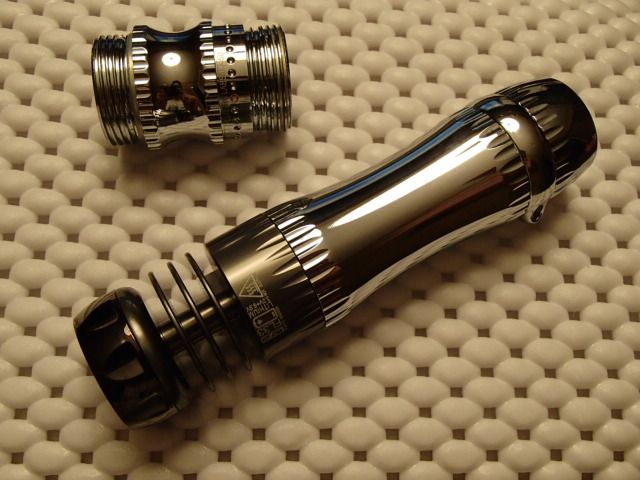In these high power mods we do, thermal management is often a limiting factor. Understanding how and which characteristics of a flashlight are desirable for good thermal management can be confusing. I have done some testing and analysis that has helped my understanding of the subject so I thought I would write something up to share.
Ultimately, it is the LED junction temperature that we want to manage. 150C is the quoted maximum junction temperature for several Cree emitters. That is very hot, much hotter than the outsides of flashlights tend to get. But because of the finite thermal conductivity of flashlight parts, the junction temperature is hotter than the body of the flashlight. Cree also quotes the thermal resistance of emitter packages. The XHP-50 thermal resistance is 1.2 (degrees C)/W. This is the thermal resistance between the junction temperature and the solder point at the bottom of the package, where the package is soldered to the MCPCB. The temperature difference between the junction and the solder point is proportional to the thermal power flowing between them. So for a high driven XHP-50, 6A(7.3V) is the input power. LEDs are typically 40-60% efficient, so 40-60% of the input power leaves as photons and don’t contribute to heat. Let’s say it is 50% efficient, so 21.9W of heat is produced, which means there is 21.9W(1.2C/W)=26.3C temperature difference between the junction and solder point.
Thermal resistance:
This brings us to the first thermal characteristic of a flashlight; the thermal resistance between the MCPCB and the surface of the flashlight where the heat fins are. This resistance should of course be minimized to maximize heat transfer to the outside of the flashlight. I measured this thermal resistance for two flashlights, the Eagle Eye X6, and the Ultrafire F13 with integrated shelf. To do this I powered an LED in the flashlight heads directly using a current regulated power supply. Without the driver in the way, I could measure the temperature of the bottom of the shelf directly below the MCPCB, using an IR thermometer. The shelf temperature should be very close to the temperature at the solder point.
I used a Latticebright LED driven at 4A, so the thermal power was approximately 9W, assuming this LED is only 40% efficient.
With the Eagle Eye X6, there was approximately a 2.8 degree C (5F) temperature difference between the shelf and the hottest part of the head where the heat fins are. This temperature difference was approximately constant as the temperature rose from 43C to 65C (~110F to 150F). So the flashlight thermal resistance is approximately 2.8C/9W=0.31C/W.
The Ultrafire F13 has an integrated shelf like the X6, but it is very thin. There was approximately a 6.7C (12F) temperature difference between the shelf and the hottest part of the head. Again, the temperature difference was approximately constant as the flashlight heated up. Thermal resistance is approximately 6.7C/9W=0.73C/W.
If we add the LED package and flashlight thermal resistances, we can know the total temperature difference between the LED junction and the flashlight head at different LED powers. Using the XHP-50 driven at 6A as an example, the total temperature difference would be 33C for the X6 and 42.3C for the F13.
So we can estimate the junction temperature if we know the head temperature, using this relation. At 140F (60C), a flashlight is hard to hold for more than a second and the junction temperature in the example above would be 93C for the X6 and 102.3C for the F13. Well below the max junction temperature of 150C. This is assuming the shelf temperature is very close to the LED package solder point temperature. Maybe someone knows the thermal resistance of the MCPCB/thermal paste/shelf joint?
Heatsinking:
Now we consider the heatsinking ability of flashlights, the ability to transfer heat to the air. I measured this characteristic for the same two flashlights. I powered the same latticebright emitter at a constant 3.2A. The electrical power was 3.6V(3.2A)=11.5W. The thermal power was then approximately 6.9W if the emitter was 40% efficient. The flashlights were mounted horizontally with the body tube installed, but no tailcap (so the power wires could reach the emitter). It was about 82F (27.8C) in the room.
In still air, the X6 head stabilized near 174F (78.9C) after 26 minutes. The F13 head stabilized near 155.5F (68.6C) after 26 minutes.
With a fan on that provided a slight airflow, the X6 head temperature stabilized at 151.5F (66.4C) and the F13 head stabilized at 136.5F (58.1C).
Now, to predict the head temperature:
Thermal power produced=(alpha)(T_h-T_a)
T_h is the head temperature and T_a is the ambient air temperature.
In equilibrium, the thermal power produced by the emitter is equal to the thermal power dissipated by the flashlight body surface. And this dissipated power is proportional to the temperature difference between the head and the air temperature. The (alpha) will be different for different flashlights and airflow conditions.
For the X6, alpha is 0.135W/C in still air and 0.178W/C in slight air flow. For the F13, alpha is 0.169W/C in still air and 0.229W/C in slight air flow.
Using the relation above, one can estimate the head temperature for different emitter powers (after the temperature is left to stabilize). Then with this head temperature along with the flashlight and LED package thermal resistances, one can estimate the LED junction temperature. However, this relation is not useful in practice for over powered lights because these lights are almost never left to equilibrate; even with the slight breeze, the F13 with XHP50 at 6A would equilibrate at 95C above ambient temperature.
Hopefully this might help someone understand or approximate the thermal characteristics of hosts.



